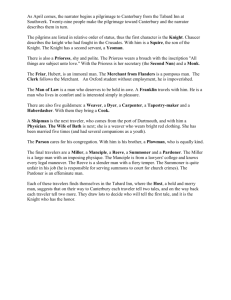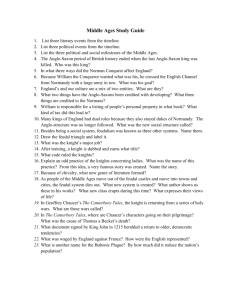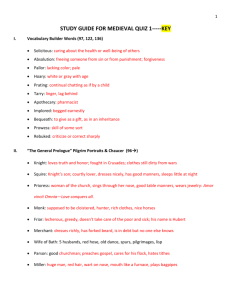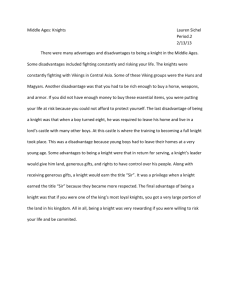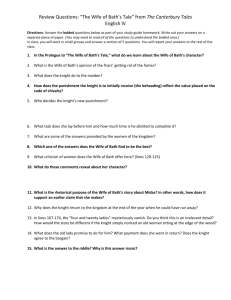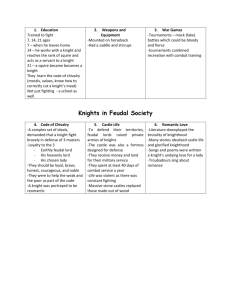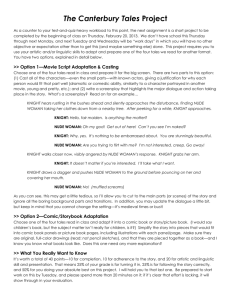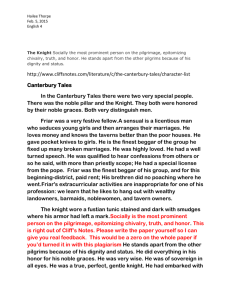The Middle Ages/The Canterbury Tales Test Study Guide Directions
advertisement
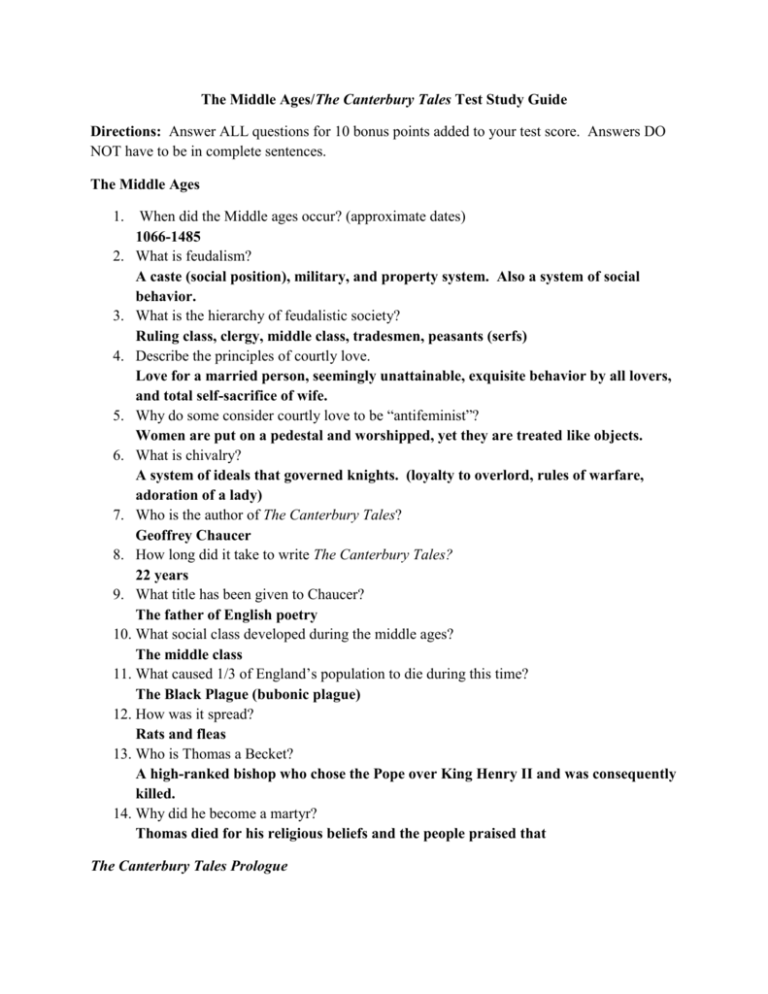
The Middle Ages/The Canterbury Tales Test Study Guide Directions: Answer ALL questions for 10 bonus points added to your test score. Answers DO NOT have to be in complete sentences. The Middle Ages 1. When did the Middle ages occur? (approximate dates) 1066-1485 2. What is feudalism? A caste (social position), military, and property system. Also a system of social behavior. 3. What is the hierarchy of feudalistic society? Ruling class, clergy, middle class, tradesmen, peasants (serfs) 4. Describe the principles of courtly love. Love for a married person, seemingly unattainable, exquisite behavior by all lovers, and total self-sacrifice of wife. 5. Why do some consider courtly love to be “antifeminist”? Women are put on a pedestal and worshipped, yet they are treated like objects. 6. What is chivalry? A system of ideals that governed knights. (loyalty to overlord, rules of warfare, adoration of a lady) 7. Who is the author of The Canterbury Tales? Geoffrey Chaucer 8. How long did it take to write The Canterbury Tales? 22 years 9. What title has been given to Chaucer? The father of English poetry 10. What social class developed during the middle ages? The middle class 11. What caused 1/3 of England’s population to die during this time? The Black Plague (bubonic plague) 12. How was it spread? Rats and fleas 13. Who is Thomas a Becket? A high-ranked bishop who chose the Pope over King Henry II and was consequently killed. 14. Why did he become a martyr? Thomas died for his religious beliefs and the people praised that The Canterbury Tales Prologue 1. Who did the narrator meet at the Tabbard Inn? He met 29 pilgrims. 2. Why was everyone at the Tabbard? They were on their way making a pilgrimage to Canterbury. 3. What were they going to Canterbury to see? They were going to see the shrine of Thomas a Becket. 4. Describe the Knight. He had been in many battles. He was a true, a perfect gentle knight. 5. Describe the Squire. He was the son of the Knight, 20-ish, agile and strong, fashionable and happy-golucky. 6. Describe the Yeoman. The Yeoman was the Squire’s servant. He was a woodsman, a Robin Hood-type character. 7. Describe the Prioress. Her name was Madam Eglantyne. She spoke French, was dainty, pleasant, sensitive, and the picture of medieval beauty (although her wide forehead was a sign that she wasn’t very bright). 8. What is a Prioress? The head nun at a convent 9. Who else was in the Nun’s group? There was another nun, and there were 3 priests. 10. Describe the Monk. He was bald and fat. He had a preference for fine clothes and luxuries. He didn’t care at all for the hard work at the monastery. He liked to ride. 11. Describe the Friar. He takes bribes for easy penance, and he knows the taverns and barmaids better than he does the lepers and beggars. He is rather aristocratic; too good for the lepers. His name is Herbert. 12. Describe the Merchant. He has a forked beard and motley coat. He is careful with money, a good negotiator, and always tells his opinions about business. He is in debt. 13. Describe the Clerk. He is an Oxford student. He didn’t say much, didn’t have a job, and just loved to learn for the sake of learning. 14. Describe the Sergeant At Law. He seemed wise (but really he had just memorized many court cases and laws). He made a lot of money as a lawyer. 15. Describe the Franklin. He looked a little like Santa Claus. He liked to eat, drink, and be merry. He was a country gentleman with a dagger and a white silk purse. 16. What are the individual occupations of the guildsmen? A haberdasher, dyer, carpenter, weaver, and a carpet-maker 17. Describe the Cook. He was a master of his trade. He had a sore on his knee, and was physically a rather disgusting character. 18. Describe the Shipman. He didn’t ride well, had little conscience about killing the enemy, and was a good navigator. He seems like a pirate. 19. Describe the Doctor. The doctor knew medicine well, but took kickbacks of money from the pharmacist. He was not particularly religious. He loves gold. 20. Describe the Wife of Bath. She was a large woman, and somewhat deaf. She had a red complexion and wore a wide hat and spurs. She had been married 5 times, and went on many pilgrimages (possibly man-hunting). 21. Describe the Parson. He was truly Christ-like; patient, giving, holy and virtuous, and didn’t believe in pomp or glory. He practiced what he preached. 22. Describe the Miller. The Miller had a football-player build. He had a red beard, wart on his nose, and a filthy mouth. He cheated his customers (took 3 times the amount he was owed) and in his spare time he played the bagpipes. 23. Describe the Manciple. He was a shrewd buyer. Lawyers with all their knowledge were no match for him. He purchased well and kept the extra money for himself. He stole the lawyers blind. He was ironically illiterate. 24. Describe the Plowman. He was the Parson’s brother. He was an honest worker who paid his taxes on time. 25. Describe the Reeve. He was old, choleric (chronic cough), and thin. He was a good manager and good carpenter, feared by the farm workers. He usually brought up the rear of the party, lagging behind. 26. Describe the Pardoner. He sang in a strong voice. He had long, yellow hair, bulging eyes, and was babyfaced. He carried a bunch of false relics to sell. He is the most corrupt and despicable of the pilgrims. 27. Describe the Summoner. He had a red face full of sores. He ate onions and drank too much. He would take bribes, and he knows many secrets. Children are afraid of him. He uses blackmail. 28. Describe the Host. His name is Harry Bailey. He was manly, good-natured, and happy. 29. What game does the host propose? He proposed that they each tell two stories on the way to and from Canterbury. The host would ride along and be the judge. 30. What is the prize for winning the game? The winner with the best story would get a free meal at the expense of the other travelers. 31. What is the penalty for anyone who doesn’t obey his rules? They would have to pay everybody’s way. The Wife of Bath’s Tale 1. When is this tale set? (i.e. during the mythic reign of what king?) During King Arthur’s reign 2. According to the Wife of Bath, why can’t people see elves anymore? The friars have gotten rid of them (fairies too). 3. What does the Wife of Bath mean when she states, “There is no other incubus than he [the friar]”? The friar is the one seducing the women. 4. What crime does the lusty bachelor commit? Why is this particularly awful? He rapes a woman; she was a virgin. 5. What is the initial punishment King Arthur orders for the knight? Who intervenes and requests a special trial? He orders the knight to be beheaded; The queen intervenes. 6. What must the knight do to save his head (i.e. what mission does the court give him)? How long does he have? He must answer the riddle of “what do women want most”. He has a year and a day. 7. What problem does the knight run into as he is attempting to complete his mission? All of the women have different answers. 8. What strange sight does the knight see while riding through the forest on his return journey? A group of 24 maidens dancing who then disappear and become one old woman. 9. What does the old woman say she wants in return for providing the answer to the knight’s riddle? She wants the knight to do whatever she asks him to do next. 10. What is the Queen and the court’s reaction to the knight’s answer? They agree. 11. What are the wedding celebrations like when the knight marries the old woman? He is sad and miserable. There are no celebrations. 12. What does the old woman teach the young knight about nobility? (i.e. What makes a person “noble” or “gentle” according to her? A person is innately noble or gentle (a gift that comes from God). Gentility cannot be bought with wealth or passed down from generations, though those people are labeled “gentlemen”. 13. According to the old woman, what are the advantages of her being poor and ugly? Because she is poor, they never need to worry about being robbed, and because she is ugly, the knight shouldn’t fear that she would be unfaithful. 14. What two options does the old woman present to the knight? She offers to stay old and ugly, yet faithful, or to become young and beautiful and to be unfaithful. 15. Which of these two options does the knight pick? (trick question!) He does not choose either option. He gives the choice to her. 16. How does the old woman change at the end of the story? She becomes young, beautiful, and faithful as well!
